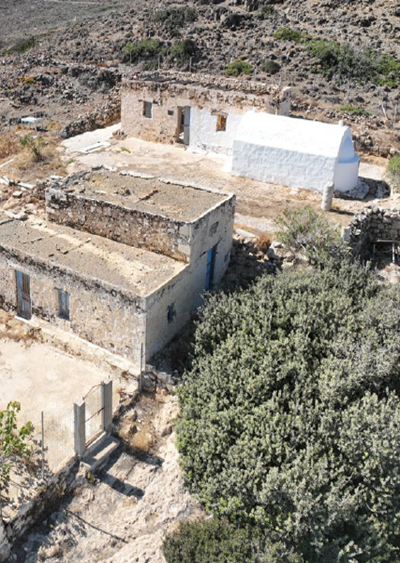
The Ministry of Culture is investing in improving visitor routes and accessibility for disabled people and people with disabilities in the archaeological site of Gortys. The interventions to maintain, enhance and improve the infrastructure of the archaeological site and the accessibility of its monuments are part of the overall project of restoration and enhancement of the archaeological site and the Great Theatre of Ancient Gortys, with a total budget of 2,500,000 euros. The aim of the project is to organise the visitors’ route for the safety of the public in difficult areas with improvements to the traffic routes and, above all, to create conditions for the safe access of disabled visitors and disabled persons in general. It also includes the organisation of viewing and staging areas and the upgrading of the parking area with provision of spaces for the disabled.
The Minister of Culture, Lina Mendoni, said: “The archaeological site of Gortys is an extremely important monumental site, in which architectural remains of a great ancient city are preserved. In combination with the recently inaugurated Messara Archaeological Museum, they constitute a cultural and tourist destination of particular interest. In close and excellent cooperation with the Region of Crete, with the ongoing interventions to improve the routes, accessibility and general upgrading of the archaeological site and its flood protection, in combination with the ongoing work on the uncovering and restoration of the Great Theatre, the Ministry of Culture is implementing a holistic plan to increase the number of visitors to the archaeological site of Gortys. With the inclusion of the site in the Cultural Routes of Crete, but also with the future use of the theatre for artistic events of high standards, we are creating an attractive cultural destination, which upgrades the tourist product offered by the wider region.”
The archaeological site of Gortys, covering an area of 27 acres, has been in operation since the 1970s and includes the following main monuments: 1. The Roman Odeon, built in the highest part of the Greek Agora, probably in the position of the Hellenistic Bouleuterion (4th-2nd century BC). On the outer wall of the circular corridor, the Inscription of the Laws of Gortys was found. The Temple of St. Titus, near the Odeon, 3. The Water Mill, known as ‘Old Savouidakis’, whose restoration is planned so that it can be functionally integrated into the site to be visited. 4. The evergreen plane tree, a preserved monument of nature, linked to the myth of the rapture of Europe by Zeus. A short distance away is the Great Theatre, the excavation of which is currently underway.
The infrastructure of the archaeological site includes a refreshment room, a sculpture gallery, sanitary facilities, an office and a ticket office. During the decade 2004-2013, there were works of enhancement, expropriation of properties and consolidation of the then visited area with new sections. A new parking area, a new entrance and a new building for the ticket office – ticket office, new planting, the promotion of the Conservatory, restoration work on the Church of St. Titus and the construction of ramps for the disabled.
With the restoration of the Water Mill and the Theatre, the archaeological site is expanded and the flow of the visit is formed into Odeon – Great Theatre Platanos – Water Mill – Temple of Agios Titus. The visitor trajectory for the general population category remains unchanged, with improvements to the infrastructure. The route for the disabled category is shaped so that there is access to the Conservatory, and inside the Conservatory. The rest of the route for the disabled, to the Grand Theatre, the Platanos, the Water Mill and the Church of St. Titus, and then to the exit, is identical to that for the general public. The Water Mill is the youngest water mill that operated until the middle of the last century, and on the basis of the study, it is planned to connect it with the archaeological site. The evergreen Platanus is being demarcated and protected. A pedestrian bridge is planned to be built near the Platanos to connect it to the Grand Theatre, which is also suitable for the disabled. The interventions do not cover the independent movement of blind people, for whom the tour should be accompanied by an escort. Handicapped spaces are created in the parking area. The archaeological site is also accessible for emergency vehicles. Stopping and viewing places are designed to accommodate all visitors and are placed in the area between the ticket office and the entrance/exit gates, in the central area overlooking the Conservatory and the century-old olive trees, and in places around the Conservatory, and on the plateau of St. Titus. As for the civic equipment, it is maintained and replaced where necessary, such as seating, bilingual signage and information signs,and in Braille, litter bins, handrails for the safety of visitors and the movement of people with disabilities.
The ancient city of Gortyna is located 45 km south of Heraklion. Together with the Acropolis and the necropolises, it occupies an area of about 4,000 acres. In 1879, Haussoullier discovered part of the inscription of the Laws, which was the occasion for the excavation of the Odeon (1st century AD), where additional parts of the inscription known as the Laws of Gortyna, the first written set of laws in Europe, were found. The city flourished in the Classical, Hellenistic and Roman eras. It came to have three markets, two aqueducts, fountains, a Hellenistic stadium, thermal baths and temples. Among the most important buildings were the Praetorium, the Odeon, the Temple of Apollo, the Acropolis and the Great Theatre. With the establishment of Christianity (380 AD), Gortys became the seat of a diocese, where the Basilica of the Metropolis and the Church of St. Titus stand out. The abandonment of Gortyna occurred between the end of the 8th and the beginning of the 9th century.







Leave A Comment